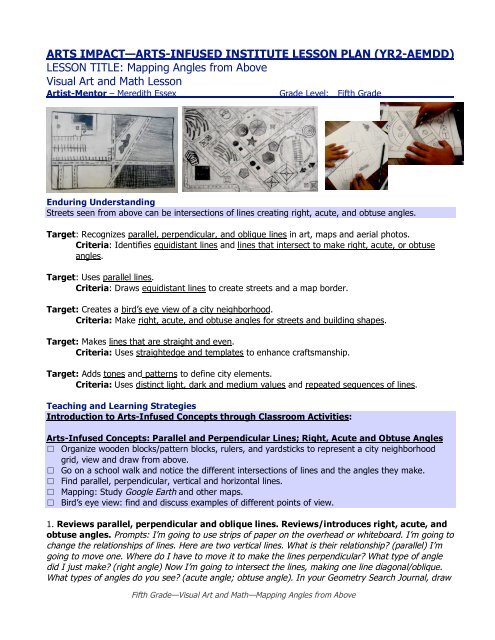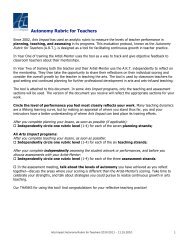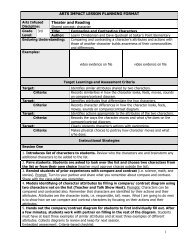LESSON TITLE: Mapping Angles from Above Visual Art ... - Arts Impact
LESSON TITLE: Mapping Angles from Above Visual Art ... - Arts Impact
LESSON TITLE: Mapping Angles from Above Visual Art ... - Arts Impact
Create successful ePaper yourself
Turn your PDF publications into a flip-book with our unique Google optimized e-Paper software.
ARTS IMPACT—ARTS-INFUSED INSTITUTE <strong>LESSON</strong> PLAN (YR2-AEMDD)<br />
<strong>LESSON</strong> <strong>TITLE</strong>: <strong>Mapping</strong> <strong>Angles</strong> <strong>from</strong> <strong>Above</strong><br />
<strong>Visual</strong> <strong>Art</strong> and Math Lesson<br />
<strong>Art</strong>ist-Mentor – Meredith Essex<br />
Grade Level: Fifth Grade<br />
Enduring Understanding<br />
Streets seen <strong>from</strong> above can be intersections of lines creating right, acute, and obtuse angles.<br />
Target: Recognizes parallel, perpendicular, and oblique lines in art, maps and aerial photos.<br />
Criteria: Identifies equidistant lines and lines that intersect to make right, acute, or obtuse<br />
angles.<br />
Target: Uses parallel lines.<br />
Criteria: Draws equidistant lines to create streets and a map border.<br />
Target: Creates a bird’s eye view of a city neighborhood.<br />
Criteria: Make right, acute, and obtuse angles for streets and building shapes.<br />
Target: Makes lines that are straight and even.<br />
Criteria: Uses straightedge and templates to enhance craftsmanship.<br />
Target: Adds tones and patterns to define city elements.<br />
Criteria: Uses distinct light, dark and medium values and repeated sequences of lines.<br />
Teaching and Learning Strategies<br />
Introduction to <strong>Art</strong>s-Infused Concepts through Classroom Activities:<br />
<strong>Art</strong>s-Infused Concepts: Parallel and Perpendicular Lines; Right, Acute and Obtuse <strong>Angles</strong><br />
Organize wooden blocks/pattern blocks, rulers, and yardsticks to represent a city neighborhood<br />
grid, view and draw <strong>from</strong> above.<br />
Go on a school walk and notice the different intersections of lines and the angles they make.<br />
Find parallel, perpendicular, vertical and horizontal lines.<br />
<strong>Mapping</strong>: Study Google Earth and other maps.<br />
Bird’s eye view: find and discuss examples of different points of view.<br />
1. Reviews parallel, perpendicular and oblique lines. Reviews/introduces right, acute, and<br />
obtuse angles. Prompts: I’m going to use strips of paper on the overhead or whiteboard. I’m going to<br />
change the relationships of lines. Here are two vertical lines. What is their relationship (parallel) I’m<br />
going to move one. Where do I have to move it to make the lines perpendicular What type of angle<br />
did I just make (right angle) Now I’m going to intersect the lines, making one line diagonal/oblique.<br />
What types of angles do you see (acute angle; obtuse angle). In your Geometry Search Journal, draw<br />
Fifth Grade—<strong>Visual</strong> <strong>Art</strong> and Math—<strong>Mapping</strong> <strong>Angles</strong> <strong>from</strong> <strong>Above</strong>
parallel and perpendicular lines. Label a right angle. Make oblique lines which intersect and label acute<br />
and obtuse angles.<br />
Student: Identifies, draws, and labels parallel, perpendicular and intersecting lines; right, acute, and<br />
obtuse angles.<br />
Embedded Assessment: Criteria-based teacher checklist<br />
2. Introduces Wayne Thiebaud’s Diagonal City. Prompts: What do you see What materials did<br />
the artist use to make his art (graphite pencil and paper) There are different types of lines that work<br />
together in this drawing What line relationships are there (parallel; perpendicular, and intersecting<br />
line) Where do you see angles What kinds of angles do you see Where do you see different areas of<br />
tone (light-to dark) What point of view do we see here<br />
Student: Identifies parallel and perpendicular lines; identifies right, acute, and obtuse angles.<br />
3. Introduces maps and aerial photographs showing a bird’s eye viewpoint. Demonstrates<br />
creating a border and mapping streets and using lines and angles to show intersections.<br />
Using right, acute, and obtuse angles can show an intersection of streets as seen <strong>from</strong> above. We want<br />
to imagine a city or a neighborhood. Pretend you’re in a helicopter or flying above your city like a bird.<br />
We want to show how people in your city or neighborhood are going to get around using streets. We<br />
need good traffic flow: no collisions. You need to get <strong>from</strong> point A to point B in the quickest possible<br />
ways. (diagonal/oblique lines) Make the streets for your City Street Plan. You could show a larger street<br />
by creating parallel lines for streams of traffic moving in two directions. Discuss why cities use one-way<br />
streets as well. I have lined up the edge of my ruler with the edge of my paper and drawn a light line<br />
parallel to all four edges. Notice how I am using my 2H pencil, which is the very lightest, to draw in my<br />
street system. Once I have established the flow of traffic I am starting to show the tops of buildings,<br />
trees and other features as seen <strong>from</strong> above just like looking at a map. Remember that a bird’s eye<br />
view is different than a side view of buildings and trees.<br />
Student: Analyzes using a bird’s eye viewpoint, observes demonstration.<br />
4. Guides students as they create a bird’s eye view of a city showing streets and roads using<br />
parallel and perpendicular lines, right, acute and obtuse angles. Prompts: We’re going to lay down<br />
some perpendicular lines, some parallel lines, and intersecting lines to create three kinds of angles:<br />
right, acute and obtuse. Once you have your streets mapped in notice the shapes of your city blocks<br />
between the streets: if your streets are straight, you have polygons. How about triangles Can you<br />
classify them—are they right, acute, obtuse Keep building your street system until you reach the<br />
edges of your border. You may want to include some open spaces, negative space. As you draw your<br />
lines don’t forget to use tools—the straightedge/ruler, and template tools for creating curved lines and<br />
other shapes/figures. Self-check to make sure that your lines are precise, straight and even.<br />
Student: Makes a city street plan.<br />
Embedded Assessment: Criteria-based teacher checklist; criteria-based self-assessment<br />
5. Demonstrates and guides students in adding areas of tone or line pattern to further<br />
define the components of their city. Prompts: Note that you have four different drawing pencils:<br />
2H which we started with is the hardest and 6B is the softest and darkest, the others are in between.<br />
Experiment! Think about how you can fill an area with a tone of gray and another with a lighter or<br />
darker tone of gray in order to lend definition to your map. Work to control the pressure and direction<br />
of your pencil; you may want all of your roads to be the same tone of gray. Add patterns of lines:<br />
repeating, straight, curved, or zigzag to define areas like rooftops or tree tops.<br />
Student: Create building entry design.<br />
Embedded Assessment: Criteria-based teacher checklist<br />
Fifth Grade—<strong>Visual</strong> <strong>Art</strong> and Math—<strong>Mapping</strong> <strong>Angles</strong> <strong>from</strong> <strong>Above</strong>
6. Facilitates criteria-based reflection. Displays city maps on the board. Prompts: Draw and<br />
label a portion of the streets seen in a peer’s map that show acute, right and obtuse angles. Draw and<br />
compare the properties/attributes of polygons you see in the negative space between streets in the<br />
maps. Describe the challenges of using the tools What kind of realizations did you have about mapping<br />
<strong>from</strong> above instead of looking at city features <strong>from</strong> the ground<br />
Student: Participates in critique<br />
Embedded Assessment: Criteria-based class critique; criteria-based peer critique<br />
Writing<br />
Classroom<br />
Writing Activity<br />
Classroom<br />
Activity<br />
ART<br />
Co- Teach<br />
ART<br />
Model/<br />
Co- Teach<br />
Writing<br />
Classroom<br />
Activity<br />
ART<br />
Supported<br />
Teach<br />
Writing<br />
Classroom<br />
Activity<br />
Writing<br />
Classroom<br />
Activity<br />
Independent<br />
Practice<br />
Writing<br />
WASL<br />
BEFORE next VISUAL ART lesson:<br />
Math Centers<br />
Math<br />
1. Create a map of neighborhood using parallel and perpendicular lines.<br />
Math<br />
2. Highlight (with pens) and classify polygons and triangles found on old city maps.<br />
Independent Practice: Hand draw it! Draw it on paper! A ”cute” angle--less than 90˚.9 An<br />
obtuse angle--more than 90˚. A right angle--exactly 90˚.900°<br />
Vocabulary Materials and Community Resource WA Essential Learnings & Frameworks<br />
<strong>Art</strong>s:<br />
negative space<br />
tone<br />
point of view<br />
<strong>Art</strong>s Infused:<br />
diagonal<br />
geometric shape<br />
horizontal<br />
intersecting<br />
parallel line<br />
pattern<br />
perpendicular line<br />
vertical<br />
Math:<br />
acute angle<br />
oblique line<br />
obtuse angle<br />
right angle<br />
Museum <strong>Art</strong>works:<br />
Maps, site plans, aerial photographs<br />
Diagonal City by Wayne Thiebaud (available for<br />
checkout through Tacoma Public Schools, part of the<br />
Take 5 <strong>Art</strong> Print Set)<br />
Google Earth<br />
model train sets<br />
blocks<br />
<strong>Art</strong> Materials:<br />
Geometry Search Journals<br />
2H, 2B and 4B, 6B graphite pencils<br />
rulers<br />
shape templates<br />
white vinyl erasers or art gum erasers<br />
6 x 9 in. OR 9 x 12 in. white drawing paper<br />
AEL 1.1 concepts: geometric shape, vertical,<br />
horizontal line, tone, pattern, angles<br />
AEL 1.1.2 principles of organization: balance<br />
AEL 1.2 skills and techniques: drafting<br />
AEL 4.2 connections between arts and other content<br />
areas: geometry: angles<br />
MATH GLE: 1.3.1 Understand properties of angles<br />
Math State Frameworks<br />
Grade 4: 1.3.1 Explains parallel and perpendicular<br />
lines and gives examples to demonstrate them<br />
Grade 5: 1.3.1 Describes a 2-dimensional shape<br />
and or figure using properties including number of<br />
sides, vertices, and types of angles.<br />
Grade 5: 1.3.2 Draws, describes, and/or labels<br />
angles, quadrilaterals, parallel and/or perpendicular<br />
lines<br />
Fifth Grade—<strong>Visual</strong> <strong>Art</strong> and Math—<strong>Mapping</strong> <strong>Angles</strong> <strong>from</strong> <strong>Above</strong>
ARTS IMPACT—ARTS-INFUSED INSTITUTE <strong>LESSON</strong> PLAN (YR2-AEMDD)<br />
<strong>LESSON</strong> <strong>TITLE</strong>: <strong>Mapping</strong> <strong>Angles</strong> <strong>from</strong> <strong>Above</strong><br />
ASSESSMENT WORKSHEET<br />
Disciplines MATH VISUAL<br />
ART AND<br />
MATH<br />
MATH VISUAL ART VISUAL ART<br />
Total<br />
8<br />
Concept LINES/ANGLES LINE LINE CRAFTSMANSHIP TONE PATTERN<br />
Student<br />
Identifies<br />
equidistant<br />
lines and lines<br />
that intersect to<br />
make right,<br />
acute, or<br />
obtuse angles<br />
Draws<br />
equidistant<br />
lines to<br />
create<br />
streets and<br />
a map<br />
border<br />
Makes<br />
right<br />
angles<br />
for<br />
streets<br />
and<br />
building<br />
shapes<br />
Makes<br />
acute,<br />
angles<br />
for<br />
streets<br />
and<br />
building<br />
shapes<br />
Makes<br />
obtuse<br />
angles<br />
for<br />
streets<br />
and<br />
building<br />
shapes<br />
Makes lines that<br />
are straight and<br />
even<br />
Uses<br />
distinct<br />
light,<br />
dark<br />
and<br />
medium<br />
values<br />
Uses<br />
repeated<br />
sequences<br />
of lines<br />
1.<br />
2.<br />
3.<br />
4.<br />
5.<br />
6.<br />
7.<br />
8.<br />
9.<br />
10.<br />
11.<br />
12.<br />
13.<br />
14.<br />
15.<br />
16.<br />
17.<br />
18.<br />
19.<br />
20.<br />
21.<br />
22.<br />
23.<br />
24.<br />
25.<br />
26.<br />
27.<br />
28.<br />
Total<br />
Percentage<br />
Criteria-based Reflection Questions: (Note examples of student reflections.)<br />
Self-Reflection: hat kind of realizations did you have about mapping <strong>from</strong> above instead of<br />
looking at city features <strong>from</strong> the ground<br />
Peer to Peer: Draw and label a portion of the streets seen in a peer’s map that show acute,<br />
right and obtuse angles. Draw and compare the properties/attributes of polygons you see.<br />
Thoughts about Learning:<br />
Which prompts best communicated concepts Which lesson dynamics helped or hindered learning<br />
Lesson Logistics:<br />
Which classroom management techniques supported learning<br />
Teacher:<br />
Fifth Grade—<strong>Visual</strong> <strong>Art</strong> and Math—<strong>Mapping</strong> <strong>Angles</strong> <strong>from</strong> <strong>Above</strong><br />
Date:
ARTS IMPACT—ARTS-INFUSED LEARNING FAMILY LETTER<br />
VISUAL ART AND MATH <strong>LESSON</strong> – <strong>Mapping</strong> <strong>Angles</strong> <strong>from</strong> <strong>Above</strong><br />
Dear Family:<br />
Today your child participated in a math and art lesson. We designed and made city street plans.<br />
• We looked at Wayne Thiebaud’s Diagonal City. We found places where the artist used parallel<br />
lines, perpendicular lines, and oblique (diagonal) lines that intersect. We analyzed the<br />
drawing and found three kinds of angles used by the artist: right angles (making an ‘L’, 90<br />
degrees), acute angles (those smaller than 90 degrees that seem sharp and pointed), and<br />
obtuse angles (angles larger than 90 degree right angles).<br />
• We reviewed how to draw parallel, perpendicular, and oblique lines and learned how to<br />
intersect those lines to make right, acute, and obtuse angles.<br />
• We thought about our city streets plan and the kinds of streets we wanted to create for our city.<br />
We drew parallel, perpendicular, and oblique lines. We talked about the open space (negative<br />
space) in areas in between our lines drawn for streets. Some of our negative space was shaped<br />
like triangles, or other straight-sided polygon shapes/figures.<br />
• We used a straightedge and templates to makes lines that are straight and even.<br />
We also added tones and patterns of lines to define city elements.<br />
• We included three kinds of angles in our drawing: right angles, acute angles, and obtuse.<br />
You could point out the types of lines and angles in your own home. You could inspect your home and<br />
pretend you were architects and wanted to remodel by changing the angle of a wall.<br />
Enduring Understanding<br />
Streets seen <strong>from</strong> above can be intersections of lines that create right, acute, and obtuse angles.<br />
Fifth Grade—<strong>Visual</strong> <strong>Art</strong> and Math—<strong>Mapping</strong> <strong>Angles</strong> <strong>from</strong> <strong>Above</strong>
















